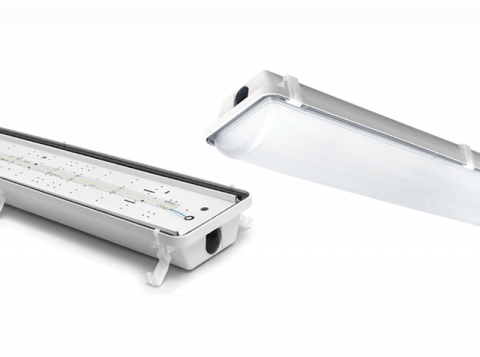
To follow up on the article from earlier this summer (Updated Vapor Tight Luminaires), some of the key takeaways mentioned in addition to our vapor tight lighting products configurability were:
- “End-user” applicable LED Luminaires
- Light fixtures using T5/T8 LED lamps
- Fluorescent light fixtures (still relevant and manufactured)
- Design Lights Consortium (DLC) Certification
The reference to the DLC Certification Standard is specifically for commercial lighting. For those who do not know, DLC is a rating system that identifies, through their testing, a manufacturer’s data regarding their luminaire’s performance that is acceptable for its intended use.
DLC Certification
Why is DLC Certified Important?
Consider this analogy: Energy Star's focus is intended to help consumers and businesses save money and protect the environment through energy-efficient products and practices. Conversely, DLC requires a manufacturer’s LED luminaires to comply with a minimum level of performance standards for lumen distribution, color, longevity and stress. When EPCO’s LED Luminaire has earned certification from DLC, it signals a high level of overall energy efficiency relative to greater LED lumen output, high efficacy, high-quality standards, and other criteria.
Historically, we (EPCO) specifically build our Linear Vapor Tight, High Bay Luminaires, and our RFK Series RetroFit Conversion Kits to the DLC 5.0 and now DLC 5.1 Certification Standard.
Why Choose a DLC Certified Luminaire?
The simple answer, a DLC certified LED luminaire is a better choice. Our LED luminaires have passed a series of stringent tests. And these tests serve as viable proof EPCO LED luminaires are efficient and high-quality, but more important they meet our claims of lumen output and light quality.
In fact, EPCO’s LED luminaires are individually tested at DLC’s laboratory, and the results are published on DLC’s web site in the Quality Products List. This assurance confirms to Contractors and Distributors they are getting the specified number of lumens, color rendering index, total harmonic distortion, and more. Visit DLC’s website for an overview of EPCO’s most recent QPL listing: designlights.org
Then enter EPCO in the QPL manufacturers search list and our Linear LED Luminaire part numbers will be listed.
Rebates
What is the Energy Rebate Program?
Who would not want to buy into an incentive program that offers cash rebates for improved lighting quality and lower energy cost? When building owners and facility managers retrofit their high-pressure sodium lamps, fluorescent lamps, or incandescent lamps to LED solid state technology, the energy company pays them a rebate for the update. That’s a good deal!
The funding is always reflected in lower electric bills. So collectively we all pay for the rebates to help reduce our demand, thus lowering the price and improving the environmental benefits.
Who Decides the Rebate Amount and Availability?
Every electric utility or co-op sets their own rates under their state laws. In most states, the majority of the programs are similar. The chart on BriteSwitch's website shows which states are actively providing rebates for new or retrofit lighting - Click Here to view the chart.
Can The Contractor Still Get Rebates For Their Projects?
If you are working on any lighting system project that will continue into 2021, make sure the product is DLC v5.0 rated. You can easily find out this rating using the DLC’s QPL tool. If the product is still showing v4.4, you’ll need to make sure the project finishes, and the final rebate paperwork is submitted before the product is delisted on February 28, 2021. If it’s a project for which you received pre-approval, contact the program writers at the utility to discuss the rebate program to see what implications this change may have on the rebate incentive.
Check with the electric utility or co-op for their current rebates for the luminaires you want to add as part of the building specification to your project to see what rebates are offered. Remember there is always a set amount of funds available for rebate programs and when funds are exhausted they stop approving rebates. The second chart provides an overview of the Average Prescriptive Rebates. However, most states have extended rebate programs well into the future.